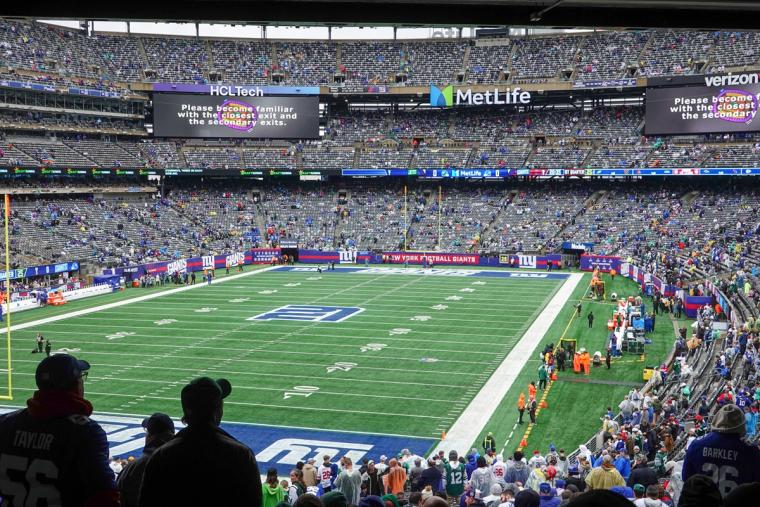
FIFA’s recent reveal of the schedule for 2026 World Cup matches has renewed discussions about natural grass vs. synthetic turf. Half of the 16 designated North American host stadiums have turf fields and likely will be required to install grass (at least temporarily) for the tournament.
As USA Today reports, World Cup regulations state that “matches shall be played on natural grass” or require “special dispensation” by FIFA.
Among the stadiums with synthetic turf are AT&T Stadium in Dallas, NRG Stadium in Houston, Mercedes-Benz Stadium in Atlanta, BC Place in Vancouver, SoFi Stadium in Los Angeles and MetLife Stadium in New York — which also will host the World Cup Final.
Work already has started at SoFi Stadium, where crews are “replacing concrete corners of the lower bowl with bleacher risers that can be rolled back during soccer matches,” according to the Associated Press. More grass also will be added to expand the playing surface for soccer.
“There was a lot written over the past few years about our venue and what it could or couldn’t do, and none of it was accurate,” Los Angeles Rams chief operating officer Kevin Demoff said. “The venue was always designed to host a World Cup. The changes that we will make to the stadium were always contemplated for the World Cup. It’s a pretty easy fix.”
Conversions at other stadiums have already begun, as well.
While FIFA’s rules stem from the desire for consistent pitches for all games, they also likely are rooted in concerns that athletes sustain more non-contact injuries on synthetic turf than natural grass. But not so fast.
New research out this month reveals that the difference between the number of noncontact lower-extremity injuries NFL players sustained on synthetic turf vs. natural grass during the 2023 season is negligible. It’s the second time in three years that a study conducted by a joint NFL/NFL Players Association committee returned similar data. (For years, the NFLPA has argued vigorously that players prefer natural grass over turf.)
According to ESPN:
 The NFL/NFLPA committee defines injuries that could be attributed to the playing surface as those that occur in the lower extremities, without contact from another player, and are serious enough to force missed games. They represent about one-third of all NFL injuries and about half of all lower-extremity injuries, according to Dr. Mackenzie Herzog, an epidemiologist at IQVIA and an adviser to the NFL and NFLPA.
The NFL/NFLPA committee defines injuries that could be attributed to the playing surface as those that occur in the lower extremities, without contact from another player, and are serious enough to force missed games. They represent about one-third of all NFL injuries and about half of all lower-extremity injuries, according to Dr. Mackenzie Herzog, an epidemiologist at IQVIA and an adviser to the NFL and NFLPA.
In 2023, the incidence rate (per 100 plays) for such injuries was 0.001 higher on synthetic turf (0.043) compared with natural (0.042). That represented a total of six to eight injuries over the course of the 17-week season, Herzog said, making the rates “virtually identical.” There was a similar difference between the rates in 2021.
In 2022, the rate for synthetic turf was 0.048 and the rate for natural was 0.035.
“Sometimes the line for synthetic injuries goes up, and sometimes it goes down, and the same for the natural turf line,” Jeff Miller, the NFL’s executive vice president for communications, public affairs and policy, told the media. “We need to have a better appreciation for why that could be over time so that both lines are heading in the same direction, and both of them are going down.”
Natural grass proponents point to New York Jets quarterback Aaron Rodgers tearing his left Achilles tendon at MetLife Stadium on the Jets’ first drive of the 2023 season as a reason to banish synthetic turf. ESPN reports that 10 other NFL players subsequently tore their Achilles during the regular season, adding that — paired with another 12 Achilles tears during preseason games and practices — the total of 23 is in line with previous seasons since the NFL moved to a 17-game regular season in 2021.
“We did not see an epidemic of Achilles injuries this year,” said Dr. Allen Sills, the NFL’s chief medical officer.
Nevertheless, the joint NFL/NFLPA committee has “several research initiatives underway,” according to ESPN, to address surface conditions. One possibility even involves potentially growing grass at indoor stadiums.

